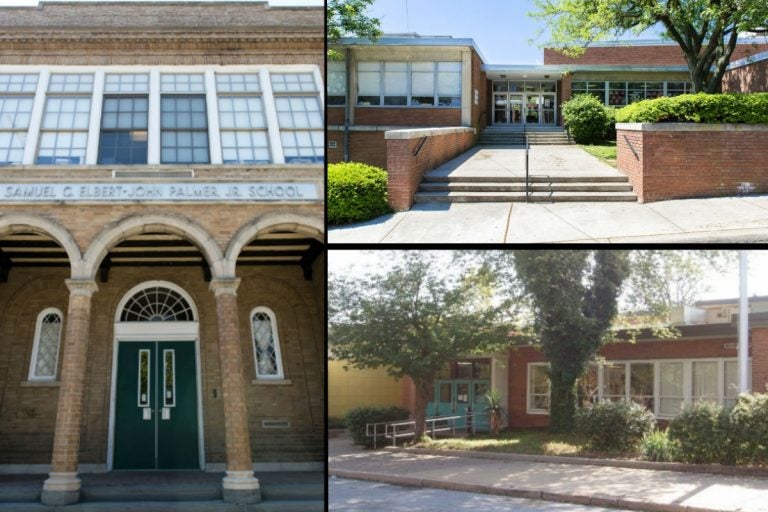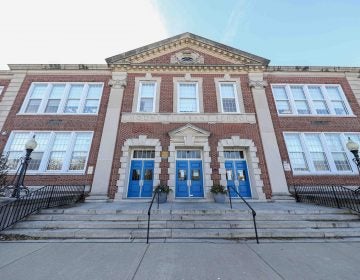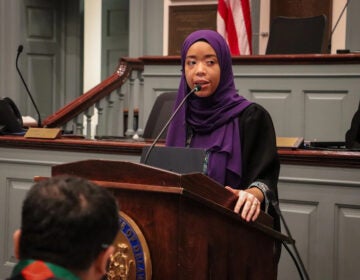Christina district, state working on proposal to close 3 schools
Christina School District is considering a plan to close three Wilmington elementary schools and expand two others in the city, according to a confidential memo.

Under a proposal by the Christina School District and the Carney administration, three schools would be closed and two expanded. Those slated for possible closure are, clockwise from left, Palmer, Pulaski and Stubbs elementary schools. (Christina School District)
Christina School District is considering a plan to close three Wilmington elementary schools and expand two others in the city, according to a confidential memo circulated among Christina officials and members of the Carney administration.
The schools that would be closed, starting next fall, would be Stubbs, Palmer and Pulaski, which together have about 900 students in kindergarten through fifth grades.
The students would be moved to Bancroft Elementary and Bayard Middle, which would be K-8 schools and be named East Wilmington and West Wilmington, respectively, the memo said. Both schools are currently at about one-third capacity and able to absorb the additional students.
Christina officials, in concert with the Carney administration, have been mulling ways to improve high-poverty, low-performing schools in the city, some of which are only one-third full.
A spokeswoman for Christina Superintendent Richard Gregg didn’t respond to a request for comment about the plan detailed in the 10-page memo that one source told WHYY is a “working draft” subject to change.
The memo, published Tuesday by the Wilmington News Journal, is a proposed memorandum of understanding between Christina officials and the state. Officials had signed a letter of intent to forge an agreement on Oct. 12. To be enacted, the Christina school board would have to approve the arrangement.
Jonathan Starkey, spokesman for Gov. John Carney, said state and district officials will hold a public meeting tonight at 6 p.m. tonight at Stubbs “to talk to parents, educators and community members about the plan.”
The governor knocked on doors in Wilmington on Tuesday night “to invite families to the meeting,” Starkey said.
A recent WHYY expose and television segment on “First” detailed the district’s problem with low-enrollment, especially at its three high schools — all located near Newark, about 15 miles from the city. A WHYY enrollment analysis found that nearly one in five Christina residents in public schools attend charter schools or schools in other districts, such as Red Clay.
Under the plan detailed in the memo, none of the schools would be sold.
Instead, Stubbs would be converted into a “dual-generation” center to provide extra services to families such as child care and job training. Palmer and Pulaski would be used for additional services such as programs for students learning English, but if the district was able to attract new students, could be converted back to school uses, the memo said.
Beyond deciding which schools get closed and expanded, the plan calls for more control by school officials over their buildings and extra services in the schools.
The memo lists overarching goals such as:
- Giving principals would get more “flexibility and autonomy’ and teachers would be empowered.
- More “learning time” for students, including a longer school day and undefined “full-year operations.”
- Out-of-school services for families such as child care and job training.
- Providing a pipeline of teachers specially trained to teach poor Wilmington students, many of whom live amid violence and in dysfunctional families, and whose proficiency is far below those of more affluent students statewide.
The situation is dire at Bayard, where 8 percent of the middle school students were proficient in standardized tests last year in English, and 4 percent proficient in math – yet more than 98 percent of the sixth, seventh and eighth graders got promoted. Carney recently told WHYY this practice at Bayard and other low-performing schools “is bordering on being immoral.”
Under the proposal, the state would commit an undefined amount of money toward school operations and building renovations.
The proposal calls for a restructuring of the collective bargaining unit between the district and the Christina Education Association.
Among other provisions, it would allow teachers who choose to work in the restructured Bancroft or Bayard schools to “secure their employment’’ for up to five years.
The memo recognizes that teachers who stay in those schools might seek additional pay, and said officials would keep meeting with educators “to understand what compensation or other supports would be most meaningful.”
WHYY is your source for fact-based, in-depth journalism and information. As a nonprofit organization, we rely on financial support from readers like you. Please give today.





